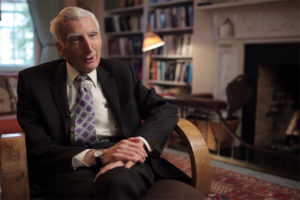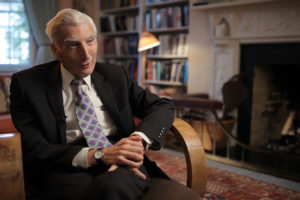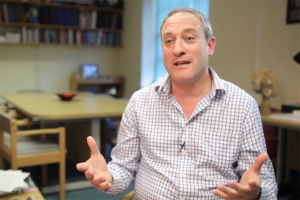The Size of the Universe
Cosmologist Martin Rees on the history of astronomy, first nanoseconds of the universe and the theory of multi...
Genetics as a science is really not much more than a hundred years old: that is, of course, Mendel, but Mendel’s work from the 1860s was forgotten for almost half a century, so it’s only about 120 years old as a science. Before that, we didn’t really know anything about inheritance at all. The strange thing is that genetics is about differences: if there were no differences, we wouldn’t have any genetics, we’d be clones, we’d be very simple clones like certain bacteria, for example.
You need differences for genetics to exist, and you need genetics to exist for evolution to exist. So the study of differences is at the heart of the study of genetics.
What’s really surprising, looking back at the recent history of the study of human differences, is how wrong everybody got it until perhaps about 50-60 years ago. We as primates are different from all other primates in that if we look across the world at the peoples of the world – Africans, Chinese, Asians, Britons, Russians – it’s clear that if you look at different people, we look different. And if you look at a particular population group, Europeans within Africans or within Chinese, to a slightly uncritical eye, we look pretty much the same. It’s a racist thing to say, but you know, to Europeans, all Chinese look the same, and Chinese find it very hard to tell your appearance apart quite often. So the assumption was that the patterns of human diversity were, first of all, very strong and on the surface. It meant that underneath the surface if we were to get towards the proteins and the DNA, we would find that within a particular population group (Africans or Europeans, shall we say), everybody would be more or less the same as they are in skin colour or facial appearance. And between the groups (between Africa and Europe, let’s say, or between Russia and China), the groups would be very, very different.
In fact, both here at UCL and elsewhere (but first of all here at UCL), in the 1960s, that assumption was blown out of the water. It was blown out of the water by Harrison and Hopkinson in what now seems an absurdly simple way. You’ve got to remember that in the 1960s, we knew almost nothing about hidden genetic diversity in humans: we knew about blood groups discovered by Landsteiner fifty or forty years before. We knew about blood groups, but we didn’t really know about anything else. So, both of these two scientists were biochemists. They knew that you could take different enzymes, a dehydrogenase, shall we say, an enzyme that breaks down things like alcohol, and you could purify them, and you could give them the stuff which they work on, their substrate, and they would break it down. It was already possible in those days to do a colouring trick with particular chemical dyes which would dye these enzymes to bring their breakdown products with particular colours.
So they did something very, very simple, which is astonishing that it hadn’t been done before. They took a group of medical students who they assumed to be typical (a strange assumption to make). So they took a group of medical students from here at UCL, and they looked at 47 of these different enzymes. The assumption was very strong in those days that every medical student, or almost everyone, would have exactly the same structure of his or her alcohol dehydrogenase or esterase B or whatever: they would all be the same. There might be some tiny differences, but everybody will be the same.
And it was a great surprise (in fact, it must have been quite a shock to discover) that of the 47 enzymes they looked at, 20 differed in their structure from person to person.
They used the technique which became universal: it is called electrophoresis. Of course, enzymes are made of proteins; they’re made of amino acids. They’re folded with little machines that can chew different chemical substances, and amino acids have charged molecules so that any difference in the order of the amino acids in that enzyme is liable to change the amount of charge on it, which may also change the shape of the molecule and might also change the size of the molecule. So what they did was to take these samples of blood from medical students and use the electrophoresis, which involves putting the samples onto a flat plate of starch. They put these little samples in, apply a powerful electric current, and the enzymes will be pulled into the starch to an extent which depends on their shape, size and charge. Then you put the stain, which responds to the activity of the enzyme, onto the piece of starch that then stains where the enzyme is. It shows that for some of the enzymes, there are two bands, sometimes more than two, as you move across from one person to the next.
So, this is the first insight into the hidden genetic variation. I did a lot of this, and a huge amount of this was done across the world using this technique to study what’s called protein polymorphism. I did it on snails, which nobody is interested in, but it’s been done on everything you can possibly imagine.
In the human context, the results were basically astonishing because the strong expectation that there would be differences between the races of the world hasn’t really held up.
If you look at the amount of genetic diversity in different human populations, when we look at proteins, it’s tiny compared to the amount of genetic diversity between, shall we say, two groups of chimpanzees that look almost the same and that live a few hundred kilometres apart in West Africa.
If you look outside Africa, the populations of the world, roughly speaking, are more or less identical to each other: they’re not entirely identical, but there’s very little genetic difference between, shall we say, Russians and Welsh people, very little indeed. There is not much genetic differentiation between Chinese people and the native people of South America. There is one slight exception to that rule, which is that if you draw a family tree of the peoples of the world using diversity, there’s one very clear pattern that there is much much more diversity within Africa and much more variation between African groups than there is outside Africa. What that tells us is something we know already from the fossil record: that every one of us across the world is an African. We are an African species of primate which got out of Africa really relatively recently. People argue about when, but the big exodus from Africa was probably only about 80 thousand years ago, and there may be some smaller ones earlier. Since then, we’ve moved across the world and filled it, and we haven’t really changed very much in that time.
But not only are there differences in the extent of the variation between Africa and, shall we say, the Middle East. As we go further and further away from Africa, the amount of human diversity goes down. The most distant human populations from Africa are the ones at the southern tip of South America, and they got there not by swimming the Atlantic and the Pacific Oceans: they got there by getting into the Middle East, getting into Russia, crossing Russia, crossing Siberia, getting into Alaska and down into the Americas only about 20,000 years ago, they have about 50% less variation than the people of Africa.
What that tells us is that there have been a series of bottlenecks, a series of tiny populations where small groups have moved on from place to place losing genes by accident as they do.
So, that’s the pattern you get from protein diversity. There’s an interesting semi-political spin on that: I worked for a time in the laboratory in Chicago with somebody called Richard Lewontin, who was very well-known and a man of strong political opinions. I remember we were discussing the discoveries found over here at UCL that the populations of the world were not particularly different, and Lewontin said, well, that’s scientific proof that racism is wrong. And I was only 23 or so, and I said, but that’s not true, racism is a political construct, it’s not a scientific construct; would it be the case that if you found the races were different, that would make racism right? And they said, prove the idea. Of course, we have found differences between Africans and Europeans, but that has nothing to do with racism.
Now, the era of protein polymorphism, looking back on it, seems like the Middle Ages because the technology now is so sophisticated that we can go straight to the DNA. We can sequence DNA at a rate and at a cost which was completely unthinkable even ten years ago. Ten years or a bit more ago, it could have cost a hundred million dollars to sequence a human DNA sequence. Now it’s down to about a thousand dollars, and it’s going down as fast. People are being sequenced all over the world: in Britain, they started the 1,000 Genomes Project, which was finished ten times faster than expected. Then it went to the 5,000 Genomes Project, then the 100,000 Genomes Project, and they’re just talking about the 5,000,000 Genomes Project, where people would pay to have their DNA sequenced. Whether it’s a good idea for people to know that DNA sequence is a different question, but this is being done.

Cosmologist Martin Rees on the history of astronomy, first nanoseconds of the universe and the theory of multi...

Cosmologist Martin Rees on life in the Solar System, artificial transmissions, and inorganic civilizations.

Neuroscientist Neil Burgess on different types of memory, the H.M. patient case, and the role of hippocampus i...